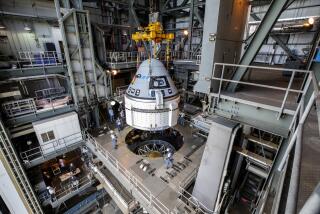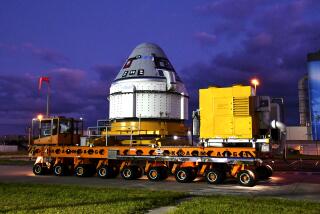Cracks in Fuel Lines Ground All Shuttles
CAPE CANAVERAL, Fla. â NASAâs shuttle fleet was grounded Friday for at least two more months because of small fuel-line cracks that the space agency fears could splinter into dangerous chunks of metal.
âWeâre not going to fly until weâre satisfied that we understand this problem,â shuttle program manager Ron Dittemore said.
At the same time, NASA is being criticized by its own inspector generalâs office for failing to provide adequate safety oversight over shuttle launching preparations by the contractor.
All four space shuttles apparently have been flying with the cracks for quite some time, perhaps since the beginning of the 21-year-old program, Dittemore said.
In all, 11 cracks have been discovered over the last month, three each in Atlantis, Discovery and Columbia and two in Endeavour. The cracks are about the same size--one-tenth to three-tenths of an inch in length.
The cracks are in the metal liners used to direct the flow of super-cold hydrogen fuel to the main engines. Columbiaâs liners are made of stainless steel; the liners in the other shuttles are a nickel alloy.
Dittemore said he does not know why the cracks were not discovered before now. âThatâs something weâre going to ask,â he said. The larger cracks are visible to the naked eye.
The original material for the liners may have been flawed from the start, Dittemore said. When the liners were welded into place, the metal may have been stressed, he said. Age is not considered a factor since the cracks have been found in NASAâs oldest shuttle as well as its newest.
Columbiaâs research flight with the first Israeli astronaut is on indefinite hold; it had been set for a July 19 liftoff. An Aug. 22 launch by Atlantis on a flight to the international space station is also off. Dittemore said the earliest a shuttle could launch is September.
If any of the cracks were to grow, chips of the metal could break off and end up in a main engine during liftoff. A piece of metal flying into a turbine rotating at thousands of revolutions per minute could have disastrous consequences.
Dittemore said engineers might conclude after a few more weeks of analysis that the cracks will not grow and no repairs will be needed.
But just in case, engineers are considering such repairs as welding or grinding or cutting out the cracks, without removing the actual plumbing.
It would be difficult to pull out the fuel lines, which are 1 foot in diameter and extend into the shuttle, Dittemore said. No spare parts are available, and it would take months to manufacture new pieces.
More to Read
Sign up for Essential California
The most important California stories and recommendations in your inbox every morning.
You may occasionally receive promotional content from the Los Angeles Times.









